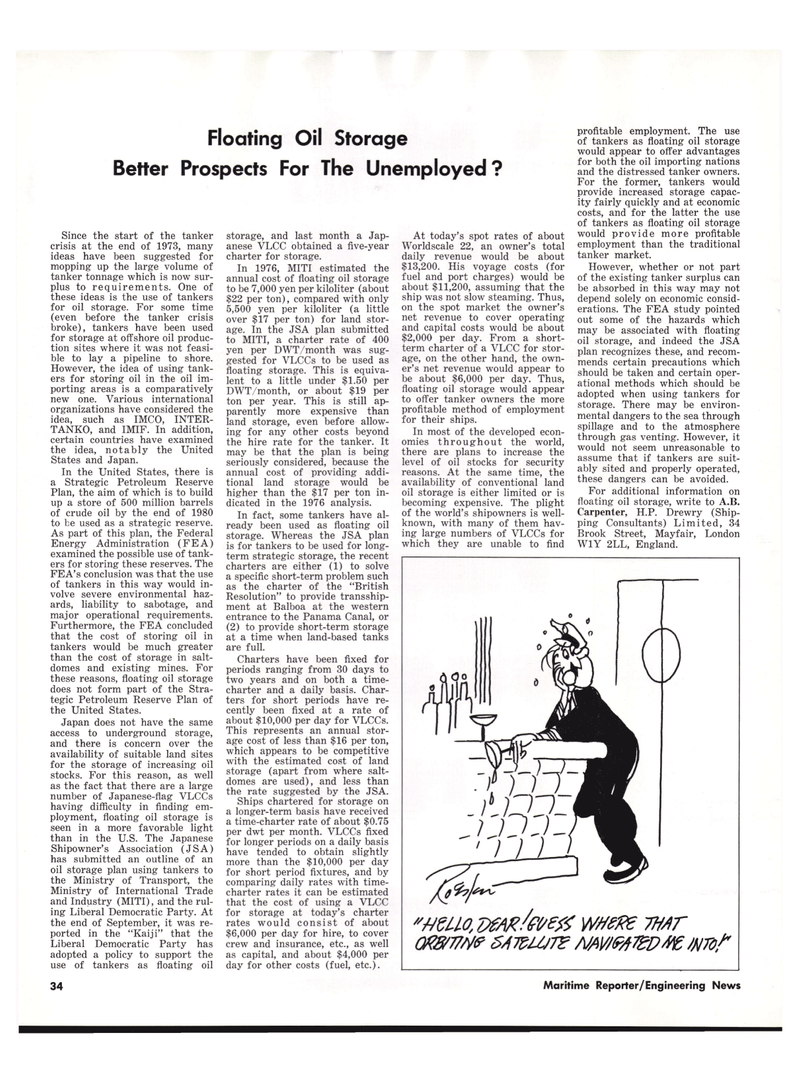
Page 32: of Maritime Reporter Magazine (November 15, 1977)
Read this page in Pdf, Flash or Html5 edition of November 15, 1977 Maritime Reporter Magazine
Floating Oil Storage
Better Prospects For The Unemployed?
Since the start of the tanker crisis at the end of 1973, many ideas have been suggested for mopping up the large volume of tanker tonnage which is now sur- plus to requirements. One of these ideas is the use of tankers for oil storage. For some time (even before the tanker crisis broke), tankers have been used for storage at offshore oil produc- tion sites where it was not feasi- ble to lay a pipeline to shore.
However, the idea of using tank- ers for storing oil in the oil im- porting areas is a comparatively new one. Various international organizations have considered the idea, such as IMCO, INTER-
TANKO, and IMIF. In addition, certain countries have examined the idea, notably the United
States and Japan.
In the United States, there is a Strategic Petroleum Reserve
Plan, the aim of which is to build up a store of 500 million barrels of crude oil by the end of 1980 to be used as a strategic reserve.
As part of this plan, the Federal
Energy Administration (FEA) examined the possible use of tank- ers for storing these reserves. The
FEA's conclusion was that the use of tankers in this way would in- volve severe environmental haz- ards, liability to sabotage, and major operational requirements.
Furthermore, the FEA concluded that the cost of storing oil in tankers would be much greater than the cost of storage in salt- domes and existing mines. For these reasons, floating oil storage does not form part of the Stra- tegic Petroleum Reserve Plan of the United States.
Japan does not have the same access to underground storage, and there is concern over the availability of suitable land sites for the storage of increasing oil stocks. For this reason, as well as the fact that there are a large number of Japanese-flag VLCCs having difficulty in finding em- ployment, floating oil storage is seen in a more favorable light than in the U.S. The Japanese
Shipowner's Association (JSA) has submitted an outline of an oil storage plan using tankers to the Ministry of Transport, the
Ministry of International Trade and Industry (MITI), and the rul- ing Liberal Democratic Party. At the end of September, it was re- ported in the "Kaiji" that the
Liberal Democratic Party has adopted a policy to support the use of tankers as floating oil storage, and last month a Jap- anese VLCC obtained a five-year charter for storage.
In 1976, MITI estimated the annual cost of floating oil storage to be 7,000 yen per kiloliter (about $22 per ton), compared with only 5,500 yen per kiloliter (a little over $17 per ton) for land stor- age. In the JSA plan submitted to MITI, a charter rate of 400 yen per DWT/month was sug- gested for VLCCs to be used as floating storage. This is equiva- lent to a little under $1.50 per
DWT/month, or about $19 per ton per year. This is still ap- parently more expensive than land storage, even before allow- ing for any other costs beyond the hire rate for the tanker. It may be that the plan is being seriously considered, because the annual cost of providing addi- tional land storage would be higher than the $17 per ton in- dicated in the 1976 analysis.
In fact, some tankers have al- ready been used as floating oil storage. Whereas the JSA plan is for tankers to be used for long- term strategic storage, the recent charters are either (1) to solve a specific short-term problem such as the charter of the "British
Resolution" to provide transship- ment at Balboa at the western entrance to the Panama Canal, or (2) to provide short-term storage at a time when land-based tanks are full.
Charters have been fixed for periods ranging from 30 days to two years and on both a time- charter and a daily basis. Char- ters for short periods have re- cently been fixed at a rate of about $10,000 per day for VLCCs.
This represents an annual stor- age cost of less than $16 per ton, which appears to be competitive with the estimated cost of land storage (apart from where salt- domes are used), and less than the rate suggested by the JSA.
Ships chartered for storage on a longer-term basis have received a time-charter rate of about $0.75 per dwt per month. VLCCs fixed for longer periods on a daily basis have tended to obtain slightly more than the $10,000 per day for short period fixtures, and by comparing daily rates with time- charter rates it can be estimated that the cost of using a VLCC for storage at today's charter rates would consist of about $6,000 per day for hire, to cover crew and insurance, etc., as well as capital, and about $4,000 per day for other costs (fuel, etc.).
At today's spot rates of about
Worldscale 22, an owner's total daily revenue would be about $13,200. His voyage costs (for fuel and port charges) would be about $11,200, assuming that the ship was not slow steaming. Thus, on the spot market the owner's net revenue to cover operating and capital costs would be about $2,000 per day. From a short- term charter of a VLCC for stor- age, on the other hand, the own- er's net revenue would appear to be about $6,000 per day. Thus, floating oil storage would appear to offer tanker owners the more profitable method of employment for their ships.
In most of the developed econ- omies throughout the world, there are plans to increase the level of oil stocks for security reasons. At the same time, the availability of conventional land oil storage is either limited or is becoming expensive. The plight of the world's shipowners is well- known, with many of them hav- ing large numbers of VLCCs for which they are unable to find profitable employment. The use of tankers as floating oil storage would appear to offer advantages for both the oil importing nations and the distressed tanker owners.
For the former, tankers would provide increased storage capac- ity fairly quickly and at economic costs, and for the latter the use of tankers as floating oil storage would provide more profitable employment than the traditional tanker market.
However, whether or not part of the existing tanker surplus can be absorbed in this way may not depend solely on economic consid- erations. The FEA study pointed out some of the hazards which may be associated with floating oil storage, and indeed the JSA plan recognizes these, and recom- mends certain precautions which should be taken and certain oper- ational methods which should be adopted when using tankers for storage. There may be environ- mental dangers to the sea through spillage and to the atmosphere through gas venting. However, it would not seem unreasonable to assume that if tankers are suit- ably sited and properly operated, these dangers can be avoided.
For additional information on floating oil storage, write to A.B.
Carpenter, H.P. Drewry (Ship- ping Consultants) Limited, 34
Brook Street, Mayfair, London
W1Y 2LL, England. "HUIO, v&x/ma wveze mr Q#3/m

 31
31

 3rd Cover
3rd Cover
